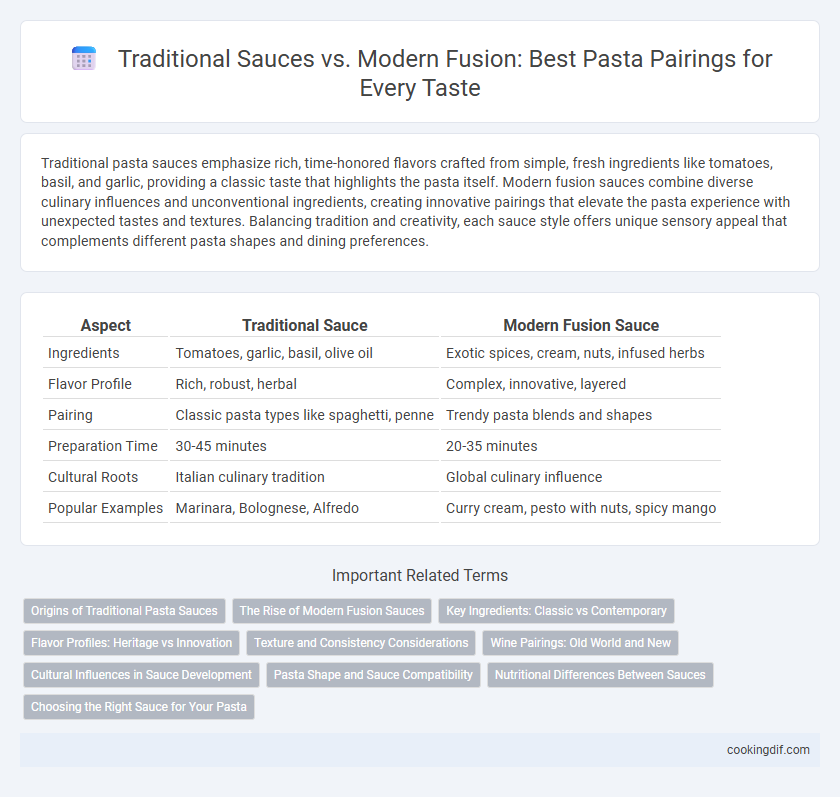Traditional pasta sauces emphasize rich, time-honored flavors crafted from simple, fresh ingredients like tomatoes, basil, and garlic, providing a classic taste that highlights the pasta itself. Modern fusion sauces combine diverse culinary influences and unconventional ingredients, creating innovative pairings that elevate the pasta experience with unexpected tastes and textures. Balancing tradition and creativity, each sauce style offers unique sensory appeal that complements different pasta shapes and dining preferences.
Table of Comparison
| Aspect | Traditional Sauce | Modern Fusion Sauce |
|---|---|---|
| Ingredients | Tomatoes, garlic, basil, olive oil | Exotic spices, cream, nuts, infused herbs |
| Flavor Profile | Rich, robust, herbal | Complex, innovative, layered |
| Pairing | Classic pasta types like spaghetti, penne | Trendy pasta blends and shapes |
| Preparation Time | 30-45 minutes | 20-35 minutes |
| Cultural Roots | Italian culinary tradition | Global culinary influence |
| Popular Examples | Marinara, Bolognese, Alfredo | Curry cream, pesto with nuts, spicy mango |
Origins of Traditional Pasta Sauces
Traditional pasta sauces, rooted in Italian culinary heritage, often emphasize regional ingredients like San Marzano tomatoes, extra-virgin olive oil, and fresh basil, reflecting centuries-old recipes from areas such as Naples and Emilia-Romagna. Classic examples include rich ragu alla bolognese, simple yet flavorful marinara, and creamy Alfredo, each showcasing a specific combination of local produce and cooking techniques passed down through generations. These sauces highlight authenticity and ingredient provenance, distinguishing them from modern fusion styles that incorporate global flavors and innovative components.
The Rise of Modern Fusion Sauces
Modern fusion sauces for pasta blend diverse culinary traditions, incorporating ingredients like Asian spices, Mediterranean herbs, and Latin American peppers to create bold, innovative flavors. The rise of these sauces reflects evolving global tastes and a desire for personalized dining experiences beyond classic tomato or cream-based options. This trend enhances pasta versatility, appealing to adventurous eaters and redefining traditional Italian cuisine with contemporary creativity.
Key Ingredients: Classic vs Contemporary
Traditional pasta sauces rely on key ingredients like San Marzano tomatoes, extra virgin olive oil, garlic, and fresh basil to create authentic, time-honored flavors. Modern fusion pasta incorporates innovative elements such as miso paste, coconut milk, or Sriracha, blending diverse culinary influences to enhance complexity and appeal. The contrast between classic simplicity and contemporary experimentation highlights evolving taste preferences and cultural integration in pasta cuisine.
Flavor Profiles: Heritage vs Innovation
Traditional pasta sauces emphasize rich, time-honored flavors like tangy San Marzano tomatoes, fragrant basil, and garlic, preserving authentic Italian heritage. Modern fusion sauces explore innovative combinations such as spicy Szechuan pepper or creamy coconut milk, blending diverse culinary cultures to create bold, unexpected taste experiences. Balancing heritage and innovation in pasta pairing enhances flavor diversity, catering to both classic preferences and adventurous palates.
Texture and Consistency Considerations
Traditional pasta sauces like marinara or Bolognese maintain a balanced texture that complements the al dente firmness of pasta, providing a harmonious mouthfeel without overpowering the dish. Modern fusion sauces often incorporate innovative ingredients such as creamy avocado or spicy sriracha, resulting in varied consistencies that can range from velvety to robustly chunky, enhancing the pasta experience with contrasting textures. Selecting the right sauce consistency is crucial to ensure it clings properly to the pasta, maximizing flavor integration and bite satisfaction.
Wine Pairings: Old World and New
Traditional pasta sauces like marinara and bolognese pair exceptionally well with Old World wines such as Chianti, Barolo, and Sangiovese, whose acidity and tannins complement tomato-based sauces and rich meat flavors. Modern fusion pasta dishes incorporating bold, unconventional ingredients often demand New World wines like California Zinfandel or Australian Shiraz, which bring fruit-forward profiles and robust body to balance complex flavors. Wine pairing enhances the dining experience by matching the regional heritage of traditional sauces with classic wine varietals, while embracing innovation through dynamic, fruit-driven wines for fusion cuisine.
Cultural Influences in Sauce Development
Traditional pasta sauces, such as marinara and carbonara, reflect deep-rooted Italian culinary customs emphasizing simplicity and regional ingredients. Modern fusion sauces incorporate diverse global flavors, blending elements from Asian, Latin, and Mediterranean cuisines to create innovative pairings. The evolution of pasta sauce highlights how cultural exchanges shape contemporary gastronomy by merging heritage with experimentation.
Pasta Shape and Sauce Compatibility
Traditional pasta sauces like marinara or Bolognese are best paired with pasta shapes that hold or trap the sauce effectively--rigatoni and fusilli complement chunky or textured sauces due to their ridges and spirals. Modern fusion sauces often blend diverse flavor profiles and thinner consistencies, pairing better with delicate pasta shapes such as angel hair or pappardelle that allow the nuanced flavors to shine without overwhelming the palate. Optimal pasta and sauce compatibility enhances texture harmony and flavor balance, crucial for an authentic culinary experience in Italian and contemporary fusion cuisine.
Nutritional Differences Between Sauces
Traditional pasta sauces like marinara or pesto typically emphasize natural ingredients such as fresh tomatoes, olive oil, garlic, and basil, offering antioxidants, healthy fats, and vitamins with low added sugars. Modern fusion sauces often incorporate diverse ingredients like cream, cheese, nuts, or exotic spices, increasing calorie density, saturated fats, and sometimes sodium content, which can affect overall nutritional balance. Understanding the differences in macronutrient profiles and micronutrient benefits helps consumers choose sauces that align with their health goals and dietary preferences.
Choosing the Right Sauce for Your Pasta
Selecting the right sauce for pasta depends on the type of noodle and desired flavor profile; traditional sauces like marinara, Alfredo, and pesto enhance classic pasta varieties by complementing their texture and taste. Modern fusion sauces incorporate global ingredients, offering unique combinations such as spicy Szechuan or creamy coconut curry that pair well with innovative pasta shapes and whole-grain options. Understanding the balance between the sauce's intensity and the pasta's surface ensures optimal flavor absorption and a harmonious dining experience.
Traditional sauce vs Modern fusion for pasta pairing Infographic

 cookingdif.com
cookingdif.com